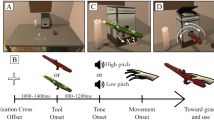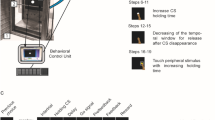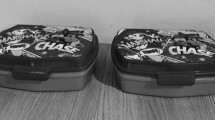Abstract
Humans and other animals have a strong propensity to explore the environment. When human infants, as well as other primates, face the opportunity to interact with the environment by manipulating objects, they may discover and learn the contingency between one action and its outcome. Thus, manipulation, as a form of spontaneous exploration, has a great biological significance, since it allows to discover and learn the relationship between action and effect, enabling humans and other animals to plan goal-directed tasks. How do the specific characteristics of the primate’s body influence this process? With its large amount of degrees of freedom, sensors, and nervous terminations, the hand is the main interface with the external world, and it profoundly influences the primates’ interaction with the environment. How does object exploration mediated by manual actions affect the acquisition of problem-solving abilities? To try to answer this question, we experimentally compared how children and capuchin monkeys (Sapajus spp.)—nonhuman primates well known for their manual dexterity and for being curious and highly manipulative—acquire new cause–effect relations through spontaneous manual exploration of a new environment. The experiments were carried out with the mechatronic board, an innovative device specifically designed to allow interspecies comparative research. The board allowed testing whether spontaneous manipulation of objects (not instrumental to achieve any specific goal) improved subjects’ ability to solve a subsequent goal-directed task by retrieving the knowledge learned during previous exploration.
Access this chapter
Tax calculation will be finalised at checkout
Purchases are for personal use only
Similar content being viewed by others
References
Aversi-Ferreira, T. A., Maior, R. S., Carneiro-e Silva, F. O., Aversi-Ferreira, R. A., Tavares, M. C., Nishijo, H., & Tomaz, C. (2011). Comparative anatomical analyses of the forearm muscles of Cebus libidinosus (Rylands et al. 2000): Manipulatory behavior and tool use. PloS one, 6(7), e22165.
Baillie, J. C. (2016). Why alphago is not AI, March 2016. Available at http://spectrum.ieee.org/automaton/robotics/artificial-intelligence/why-alphago-is-not-ai. Cited 20 December 2016.
Bertenthal, B., & Von Hofsten, C. (1998). Eye, head and trunk control: the foundation for manual development. Neuroscience and Biobehavioral Reviews, 22(4), 515–520.
Bortoff, G. A., & Strick, P. L. (1993). Corticospinal terminations in two new-world primates: Further evidence that corticomotoneuronal connections provide part of the neural substrate for manual dexterity. The Journal of Neuroscience, 13(12), 5105–5118.
Byrne, G., & Suomi, S. J. (1996). Individual differences in object manipulation in a colony of tufted capuchins. Journal of Human Evolution, 31(3), 259–267.
Christel, M. I., & Fragaszy, D. (2000). Manual function in Cebus apella digital mobility, preshaping, and endurance in repetitive grasping. International Journal of Primatology, 21(4), 697–719.
Cioni, G., & Giuseppina, S. (2013). Pediatric neurology part I: Chapter 1. In Normal psychomotor development. Elsevier Inc. Chapters, 111.
Costello, M. B., & Fragaszy, D. M. (1988). Prehension in Cebus and Saimiri: I. grip type and hand preference. American Journal of Primatology, 15(3), 235–245.
Cutkosky, M. R. (1989). On grasp choice, grasp models, and the design of hands for manufacturing tasks. Robotics and Automation, IEEE Transactions on, 5(3), 269–279.
Fallang, B., Saugstad, O. D., & Hadders-Algra, M. (2000). Goal directed reaching and postural control in supine position in healthy infants. Behavioural Brain Research, 115(1), 9–18.
Focaroli, V., Taffoni, F., & Iverson, J. M. (2015). Motor planning ability in typically developing children and children with autism spectrum disorder. Psicologia Clinica dello Sviluppo, 19(1), 3–26.
Fragaszy, D. M., & Adams-Curtis, L. E. (1991). Generative aspects of manipulation in tufted capuchin monkeys (Cebus apella). Journal of Comparative Psychology, 105(4), 387.
Fragaszy, D. M., & Boinski, S. (1995). Patterns of individual diet choice and efficiency of foraging in wedge-capped capuchin monkeys (Cebus olivaceus). Journal of Comparative Psychology, 109(4), 339.
Fragaszy, D. M., & Crast, J. (2016). Functions of the hand in Primates. In The evolution of the primate hand: Anatomical, developmental, functional, and paleontological evidence (pp. 313–344). New York: Springer.
Fragaszy, D. M., Visalberghi, E., & Fedigan, L. M. (2004). The complete capuchin: The biology of the genus Cebus. Cambridge: Cambridge University Press.
Iverson, J. M. (2010). Developing language in a developing body: The relationship between motor development and language development. Journal of Child Language, 37(02), 229–261.
Kapandji, I. A. (1987). The physiology of the joints: Lower limb (vol. 2). Elsevier Health Sciences.
Kaplan, F., & Pierre-Yves, O. (2007). In search of the neural circuits of intrinsic motivation. Frontiers in Neuroscience, 1(1), 225–242.
Lynch Alfaro, J. W., Boubli, J. P., Olson, L. E., Di Fiore, A., Wilson, B., Gutiérrez-Espeleta, G. A., et al. (2012a). Explosive pleistocene range expansion leads to widespread amazonian sympatry between robust and gracile capuchin monkeys. Journal of Biogeography, 39(2), 272–288.
Lynch Alfaro, J. W., Silva, J. D. S. E., & Rylands, A. B. (2012b). How different are robust and gracile capuchin monkeys? An argument for the use of Sapajus and Cebus. American Journal of Primatology, 74(4), 273–286.
Napier, J. R. (1956). The prehensile movements of the human hand. Bone & Joint Journal, 38(4), 902–913.
O’Regan, J. K., & Noë, A. (2001). A sensorimotor account of vision and visual consciousness. Behavioral and Brain Sciences, 24(05), 939–973.
Out, L., van Soest, A. J., Savelsbergh, G. J., & Hopkins, B. (1998). The effect of posture on early reaching movements. Journal of Motor Behavior, 30(3), 260–272.
Padberg, J., Franca, J. G., Cooke, D. F., Soares, J. G., Rosa, M. G., Fiorani, M., et al. (2007). Parallel evolution of cortical areas involved in skilled hand use. The Journal of Neuroscience, 27(38), 10106–10115.
Panger, M. A. (1998). Object-use in free-ranging white-faced capuchins (Cebus capucinus) in costa rica. American Journal of Physical Anthropology, 106(3), 311–321.
Perry, S., & Manson, J. H. (2008). Manipulative monkeys. Harvard University Press.
Polizzi di Sorrentino, E., Sabbatini, G., Truppa, V., Bordonali, A., Taffoni, F., Formica, D., et al. (2014). Exploration and learning in capuchin monkeys (Sapajus spp.): the role of action–outcome contingencies. Animal Cognition, 17(5), 1081–1088.
Preuschoft, H., & Chivers, D. J. (2012). Hands of primates. Berlin: Springer.
Rochat, P., & Goubet, N. (1995). Development of sitting and reaching in 5-to 6-month-old infants. Infant Behavior and Development, 18(1), 53–68.
Sabbatini, G., Meglio, G., & Truppa, V. (2016). Motor planning in different grasping tasks by capuchin monkeys (Sapajus spp.). Behavioural Brain Research, 312, 201–211.
Spencer, J. P., Vereijken, B., Diedrich, F. J., & Thelen, E. (2000). Posture and the emergence of manual skills. Developmental Science, 3(2), 216–233.
Spinozzi, G., Castorina, M. G., & Truppa, V. (1998). Hand preferences in unimanual and coordinated-bimanual tasks by tufted capuchin monkeys (Cebus apella). Journal of Comparative Psychology, 112(2), 183.
Spinozzi, G., Laganà, T., & Truppa, V. (2007). Hand use by tufted capuchins (Cebus apella) to extract a small food item from a tube: Digit movements, hand preference, and performance. American Journal of Primatology, 69(3), 336–352.
Spinozzi, G., Truppa, V., & Laganà, T. (2004). Grasping behavior in tufted capuchin monkeys (Cebus apella): Grip types and manual laterality for picking up a small food item. American Journal of Physical Anthropology, 125(1), 30–41.
Taffoni, F., Formica, D., Schiavone, G., Scorcia, M., Tomassetti, A., Polizzi di Sorrentino, E., et al. (2013). The “mechatronic board”: A tool to study intrinsic motivations in humans, monkeys, and humanoid robots. In Intrinsically motivated learning in natural and artificial systems (pp. 411–432). Berlin: Springer.
Taffoni, F., Formica, D., Zompanti, A., Mirolli, M., Balsassarre, G., Keller, F., & Guglielmelli, E. (2012a). A mechatronic platform for behavioral studies on infants. In 2012 4th IEEE RAS & EMBS International Conference on Biomedical Robotics and Biomechatronics (BioRob) (pp. 1874–1878). IEEE.
Taffoni, F., Tamilia, E., Focaroli, V., Formica, D., Ricci, L., Di Pino, G., et al. (2014). Development of goal-directed action selection guided by intrinsic motivations: an experiment with children. Experimental Brain Research, 232(7), 2167–2177.
Taffoni, F., Vespignani, M., Formica, D., Cavallo, G., Polizzi di Sorrentino, E., Sabbatini, G., et al. (2012b). A mechatronic platform for behavioral analysis on nonhuman primates. Journal of Integrative Neuroscience, 11(01), 87–101.
Terborgh, J. (1983). Five New World primates: A study in comparative ecology. Princeton University Press.
Truppa, V., Spinozzi, G., Laganà, T., Mortari, E. P., & Sabbatini, G. (2016). Versatile grasping ability in power-grip actions by tufted capuchin monkeys (Sapajus spp.). American Journal of Physical Anthropology, 159(1), 63–72.
Visalberghi, E. (1988). Responsiveness to objects in two social groups of tufted capuchin monkeys (Cebus apella). American Journal of Primatology, 15(4), 349–360.
Visalberghi, E., Cavallero, S., Fragaszy, D. M., Izar, P., Aguiar, R. M., & Truppa, V. (2015a). Making use of capuchins’ behavioral propensities to obtain hair samples for DNA analyses. Neotropical Primates, 22, 89–93.
Visalberghi, E., & Fragaszy, D. (2006). What is challenging about tool use? the capuchin’s perspective. In E. A. Wasserman, T. R. Zentall (Eds.), Comparative cognition: Experimental explorations of animal intelligence (pp. 529–552).
Visalberghi, E., Sirianni, G., Fragaszy, D., & Boesch, C. (2015b). Percussive tool use by Taï western chimpanzees and fazenda Boa Vista bearded capuchin monkeys: A comparison. Philosophical Transactions R Society B, 370(1682), 20140351.
Zander, S. L., & Judge, P. G. (2015). Brown capuchin monkeys (Sapajus apella) plan their movements on a grasping task. Journal of Comparative Psychology, 129(2), 181.
Zander, S. L., Weiss, D. J., & Judge, P. G. (2013). The interface between morphology and action planning: A comparison of two species of New World monkeys. Animal Behaviour, 86(6), 1251–1258.
Acknowledgements
This work was funded by FP7-ICT program (project no. ICT-2007.3.2-231722—IM-CLeVeR)
Author information
Authors and Affiliations
Corresponding author
Editor information
Editors and Affiliations
Rights and permissions
Copyright information
© 2017 Springer International Publishing AG
About this chapter
Cite this chapter
Taffoni, F., Polizzi di Sorrentino, E., Sabbatini, G., Formica, D., Truppa, V. (2017). Primates’ Propensity to Explore Objects: How Manual Actions Affect Learning in Children and Capuchin Monkeys. In: Bertolaso, M., Di Stefano, N. (eds) The Hand. Studies in Applied Philosophy, Epistemology and Rational Ethics, vol 38. Springer, Cham. https://doi.org/10.1007/978-3-319-66881-9_4
Download citation
DOI: https://doi.org/10.1007/978-3-319-66881-9_4
Published:
Publisher Name: Springer, Cham
Print ISBN: 978-3-319-66880-2
Online ISBN: 978-3-319-66881-9
eBook Packages: Religion and PhilosophyPhilosophy and Religion (R0)




